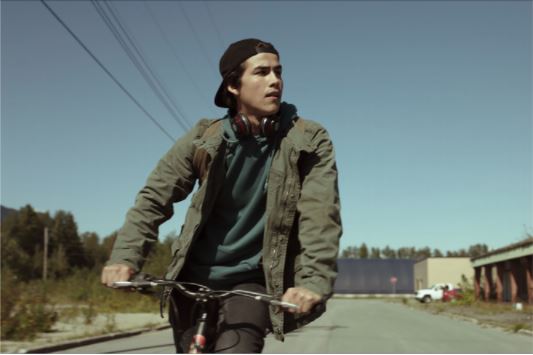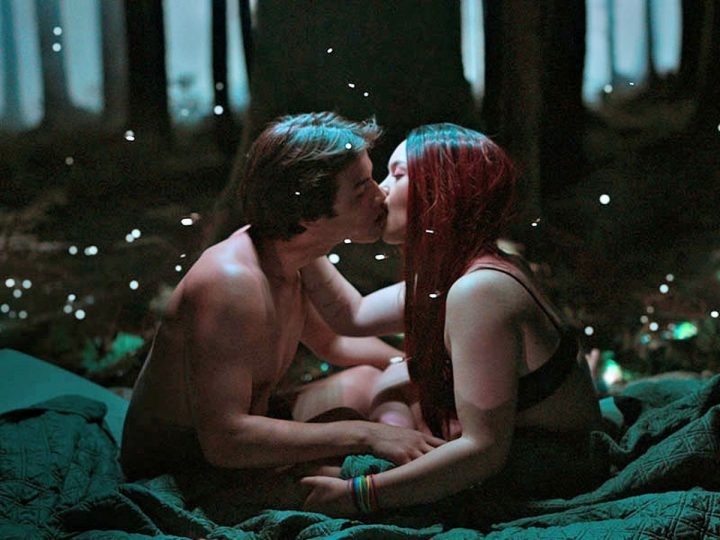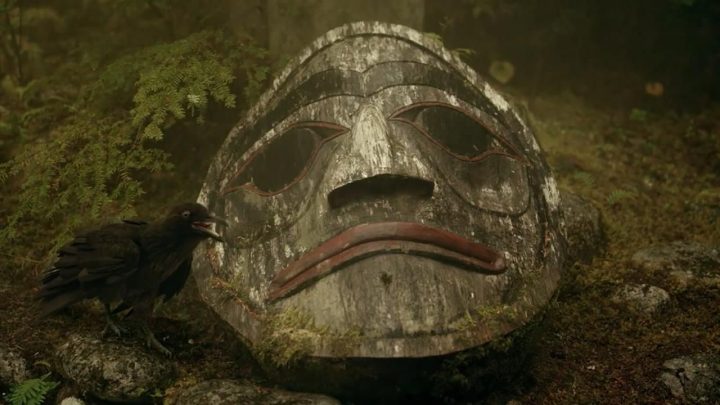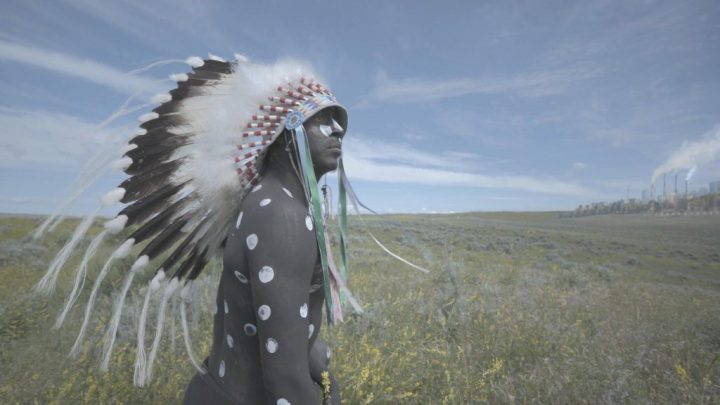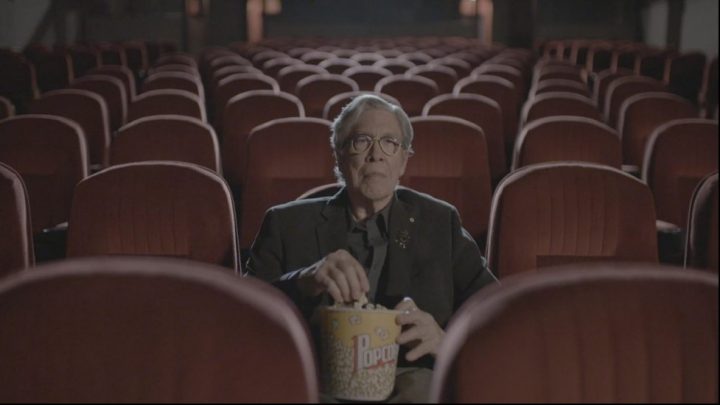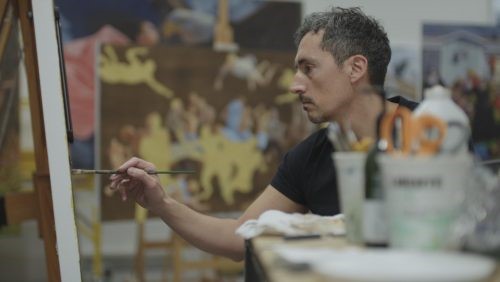[Editorial note: In late August 2020, Mirella Bontempo, a long-time Serai contributor, submitted a pitch for reviewing Indigenous films at the Toronto International Film Festival (TIFF). She was able to obtain pre-screening links to Trickster and Inconvenient Indian, and submitted her reviews in the fall. Then the Michelle Latimer bombshell exploded. After consultations with our editorial board, we decided to go ahead with the review, in recognition of all the Indigenous artists and contributors to these productions who had justifiably assumed that Ms. Latimer’s claims of Indigenous identity had been substantiated. Latimer and two producers of Trickster have now resigned—but the significance of these works, along with the livelihoods of the contributors, are suffering in the fallout.]
Trickster
Trickster, a Canadian Broadcasting Corporation (CBC) television series directed by Michelle Latimer and adapted from Eden Robinson’s speculative fiction Trickster trilogy, Son of a Trickster
When Robert Lepage claimed that he couldn’t find good, professional Indigenous French-speaking actors for his play, Kanata, Indigenous actors in Québec spoke out. Perhaps he didn’t look into the new generation of actors emerging nationally. Michelle Latimer, who also came from a theatre background and adapted Eden Robinson’s Son of a Trickster trilogy for television, seemed to have no trouble finding professional Indigenous actors, including the eponymous Trickster. Latimer was adamant that the production crew behind the camera had to be Indigenous as well. This would prove to be ironic. Unbeknownst to everyone involved in the series and the author behind the books, the director’s own claimed Indigenous identity wouldn’t pass muster. With the ensuing fallout, another person will direct the second season of Trickster.
Trickster tells the coming-of-age story of Jared, a Haisla teen in Kitamaat, B.C. On the surface, it may appear like an Indigenous Young Adult television series with elements of the supernatural – a sort of Northwest Coast-tinged magic realism with shapeshifting humanoid tricksters who tell “half-truths.”
Right from the first episode, we are reminded of the Highway of Tears, ‘sixties scoops, gas pipeline workers in white pick-up trucks, mental illness or supernatural hallucinatory holograms, inter-generational trauma manifested in alcohol and drug abuse, and family neglect, with an impotent addicted father and an abusive white drug dealer who takes over his Indigenous girlfriend’s home. The series’ colour schemata are part of the symbolism at play: white and red trucks for white and Indigenous, respectively; a couple copulating on green bedsheets and blankets representing the creation of Turtle Island.
The Raven as a trickster animal, guardian spirit, transformer and originator of the Northwest, is omnipresent. The Windigo (Wechuge) character also appears, but to understand its symbolism, the viewer needs to be cognizant of Indigenous mythology. Its traits include cannibalism and greed, and it is associated with ice, environmental destruction, and famine. As the Windigo character explains, “We were all family: witches, tricksters, what the ancients call cycles, balances and harmony.”
Pacific Northwest Coast art is featured throughout – totems, spruce-bark hats, a raven mask carving in trees in the forest – for shapeshifting tricksters turn into trees and rocks. All the historical art and narrative elements of Trickster culminate in a rite of passage ceremony.
Fireflies represent knowledge, illumination, the ecosystem and communication. Sara, the new-to-town colourful-wigged activist girlfriend, is surrounded by a halo of fireflies, and prods the un-woke Jared, who claims that there is nothing to do in town unless you are an oil worker. “Did you know gas and oil workers here are a direct link to industrial exploitation and violence against Indigenous women?” she enlightens him. Jared makes fun of her activism as “reclaim this, re-colonize that,” whereas she asserts she is “hardcore resistance with a dash of sparkle.” She organizes die-ins protesting fossil fuel, and sews moccasins against culture vultures. After growing up in the foster system, Sara is intent on finding her birth parents, while for Jared, the layers of mystery enshrouding his origins get peeled away with every episode.
Flashbacks take us to the colonial era, where one character in an alternative reality in the past sells beaver pelts in exchange for alcohol from the White Man, and his spiritual nemesis harasses him in both dimensions. She exclaims, “I want you to hear what I hear, thousands skinned alive. I hear the land and its screams of pain.” The physical and supernatural worlds collide, attesting to why the speculative genre lends itself well to narration of the non-dominant experience.
This CBC series has been picked up by SyFy UK and CW for U.S. distribution, and part of the universal attraction may be the public’s curiosity (and ignorance) about Indigenous lore.
Indigenous truth-telling in Inconvenient Indian
In recent years, Michelle Latimer has become a recognized name in documentary film in Canada, since the launch of her VICELAND documentary series about the Standing Rock pipeline protests. Environmental and Indigenous land rights activism in that series, RISE, is also highlighted in Inconvenient Indian. Latimer came into the limelight after winning two TIFF awards: The People’s Choice Documentary Award and the Amplify Voices Award for Canadian feature film. The latter was for underrepresented BIPOC and women, which was awarded before her claimed Indigenous identity was questioned.
Just as the book by Cherokee-Greek-American author Thomas King, The Inconvenient Indian, prefers a storyteller’s approach over that of a historian, the documentary adaptation relies on a variety of modes, like re-enactments and visual vignettes. When it does become traditional in observant mode in the latter half of the documentary, the visual break creates unevenness but never detracts from this expository documentary’s message.
Arcane representations of what King calls the “Dead Indian” archetype stand in contrast with the issues facing “Live Indians’” traditional knowledge, languages and food systems and other traditions from the original way of life that the residential school system attempted to obliterate through forced assimilation. Living artists are reclaiming their identities in contemporary arts such as facial tattoos (see the film Tunniit: Retracing the Lines of Inuit Tattoos by Inuk filmmaker Alethea Arnaquq-Baril) and protest music from groups like A Tribe Called Red.
The documentary also contains a tacit critique of paternalistic white commentators who admonish seal hunters. A hunter in the North reflects on the changes his mother has witnessed in her lifetime, after being “born onto the land into a semi-nomadic lifestyle following the hunting seasons,” and now living in an institutionalized community. “When we try to capture our traditions again, our culture revitalized,” he comments, “we get criticized for it. Not fair at all.”
We are introduced to one of the emblematic animal symbols to many Indigenous nations, the vain Coyote, a trickster character akin to a thief, and to the story of the ducks, as an implicit metaphor between settler and Indigenous relations. Coyote has an insatiable desire for feathers from the ducks, who end up acquiescing: “Half (plucked) is better than being eaten.”
In Inconvenient Indian, museums celebrate artefacts of the Dead Indian: “Most of the history of Indians in North America has been erased. We are left with a series of historical artefacts or memorial tokens of static voiceless objects from the past, unthreatening and without agency. Dead Indians … stereotypes that North America conjured up in collective imaginings and fears. More importantly, a source of entertainment.”
The segment on Robert Flaherty’s Nanook of the North (1922), with pulsating editing to Tanya Tagaq Gillis’ throat-singing, is characteristic of the director’s style. The jump cut licking of the sword is accentuated twice. In film history, this silent documentary is remembered for its anachronistic use of harpoons when the Inuit had long abandoned them for rifles. It was the first filmic representation of the Noble Savage archetype, the continuation of the Primitive, in the inception of the documentary genre. According to King, “The idea of the Indian is more important than the reality. Nobody wants the Indian. They want the idea because the idea is non-threatening.”
The Hollywood Western montage fused with the children’s tune Ten Little Indians brings dynamism to the images of stereotypical shy girls in headdresses played by non-Indigenous actors. The montage includes Daniel Boone, the Lone Ranger and Buffalo Bill in Tomahawk Territory (1952), along with mirror sideshows, arrows, and characters from Riders of the Whistling Skull (1937), Stagecoach (1939), She wore a Yellow Ribbon (1949), and Escape from Fort Bravo (1953) exclaiming: “We own this land,” “Don’t show your face,” “blood-thirsty Indians,” “they all look alike to me,” and “the only good Indian is a dead Indian.”
King’s Dead Indian is an archetype born from Post-Contact conversion to Christianity and trade in North America. Modern living Indigenous Peoples “don’t look like that… (It) makes us invisible. Unless we are looking like Indians and acting like Indians (according to) what the media have in mind, we really don’t exist.” Modern expressions of the Dead Indian are motifs such as sacred headdresses that dominant cultures co-opt for Halloween costumes, zombie walks, or Coachella apparel.
Cree artist Kent Monkman and their Two-Spirit alter-ego, Miss Chief Eagle Testikle, mention how Canada’s 150th anniversary spurred their Shame and Prejudice: A Story of Resilience exhibit at the McCord Museum in Montréal. Monkman’s Confederation paintings, diorama and ceramics convey “the worst 150 years in Indigenous peoples’ history” – “the signing of treaties, the Indian Act, proselytization, dispossession of land, residential schools, the penitentiary system and the legacy of the foster system. The colonial system exacted multi-generational traumas in Indigenous communities,” as revealed in their Winnipeg off-reservation series The Urban Rez. His painting “The Scream” depicts the brutal raids by the RCMP (Royal Canadian Mounted Police) and the clergy to abduct children from their families and communities and force them into residential schools.
The camera depicts a Northern community, with a barren landscape except for the houses and swings.
You can’t judge the past by the present.
It’s a splendid slogan. It permits us to set aside the missteps of history and offers a covenant for the future, allowing us to be held blameless for the decisions we make today. Ignorance. This is their defence. Our grandparents didn’t know any better. (…) If we knew then what we know now, we wouldn’t have done what we did.
(…) Perhaps it is unfair to judge the past by the present. But it is also necessary. In the history of Indian-white relations, it has been the Federal authorities, politicians, clergy that knew the potential for destruction their actions would have on Native communities. (…) They were able to make these decisions because they weren’t betting with their money. They weren’t betting with their communities. They weren’t betting with their children.
Thomas King
The most elegiac images in the documentary are overhead shots of the land and emptied cavities of the tar sand pits’ scarred landscape, with a bloodcurdling scream in the soundtrack from Peter Mettler’s film commissioned by Greenpeace Canada, Petropolis: Aerial Perspectives on the Alberta Tar Sands. Latimer’s activist lens tells us that all environmental issues and land rights are one and the same, since the Indigenous Peoples are stewards of the land.
Sure, whites want us to assimilate. They want Indians to realize that everything whites do is for our own good. We can’t make good decisions for ourselves…The issue that has never changed and is with us to this day is the issue of land. The issue has always been land, will always be land. The vast beauty of Canadian forests. Indians systematically removed all over Turtle Island, for the settlers to have access to the resources.
Thomas King
And the land is imbued with spirituality, as the female voice-over explains:
Inherent within the belief systems of Indigenous peoples across Turtle Island, there is an understanding (that) we are the land. The land is us. We believe that there are spirits existing in the land, in the forest – that the earth is alive. We don’t have a right to things. We have a responsibility. When you live like that, the pace slows down.
Inconvenient Indian is an important visual and didactic essay that ends with a positive vision of the future, thanks to “Live Indian” artists and youth. As Concordia University’s Manon Tremblay puts it as head of Indigenous Directions, overseeing AbTeC – Aboriginal Territories in Cyberspace: “It gets better. We aren’t surviving but thriving.” The animation in Second Life is created by young Mohawks such as Skawennati, whose oral traditions get transcribed for a digital age where “an avatar gives thanks to the waters in a virtual land.”
Thomas King’s reframing of the question of Indigenous demands is reflected in the major stand-offs – from the Oka Crisis to the Wet’suwet’en Coastal GasLink pipeline challenge to Mi’kmaq lobster fishing rights’ protests – as “What do whites want? You can drink water, feed all territories, and never see an injunction. Your army and police are breaking your own laws, trespassing on Mohawk land and removing (them) forcibly with semi-automatics. There is little shelter and little gain for Native Peoples to do nothing, when all we possess is unseen sovereignty on parts of the land… The question will be, how badly do we want sovereignty and self-determination? How important is it to protect our homelands? Are our traditions and language worth the cost of carrying on the fight?”
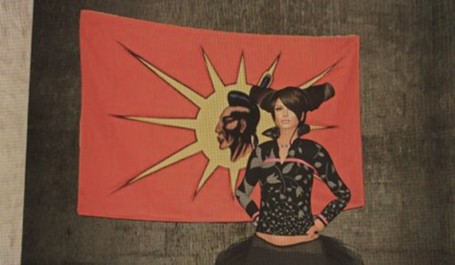
Still from Inconvenient Indian, mixed media artist Skawennati’s TimeTravellers series | Image source: NFB
